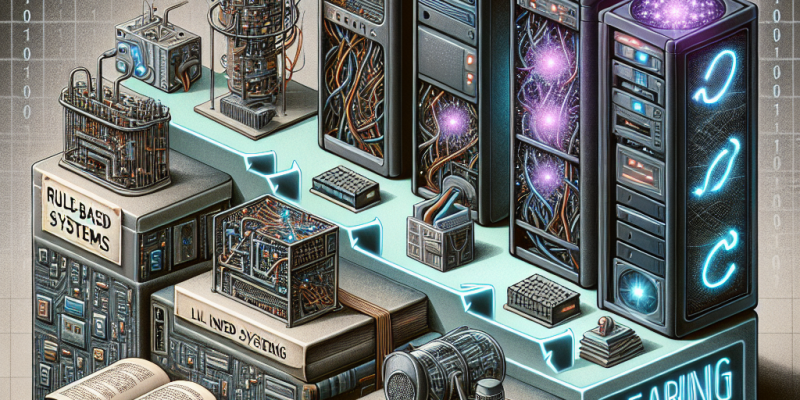The Evolution of NLP: A Journey from Rule-Based Systems to Deep Learning

Natural Language Processing (NLP) represents a fascinating intersection of computer science and linguistics, allowing machines to understand, interpret, and generate human language. Over the decades, NLP has undergone a remarkable evolution, transitioning from simplistic rule-based systems to the sophisticated deep learning architectures of today. This article explores this transformative journey, highlighting key developments and the implications for future advancements.
1. The Beginnings: Rule-Based Systems
The roots of NLP can be traced back to the 1950s, when researchers began exploring ways to enable computers to process human language. Early NLP systems were largely rule-based, relying on hand-crafted rules that attempted to encapsulate linguistic knowledge. These systems employed techniques such as parsing, where sentences were broken down into grammatical components through predefined syntactic rules.
One of the landmark achievements during this period was ELIZA, a program created by Joseph Weizenbaum in the mid-1960s. ELIZA simulated conversation by applying pattern matching and substitution rules to user input, mimicking a psychotherapist’s style of response. Although groundbreaking at the time, ELIZA and similar systems were ultimately limited in their ability to understand context or handle the complexities of natural language.
2. The Statistical Revolution
The 1980s and 1990s heralded a new era for NLP with the advent of statistical methods. Researchers began to abandon rigid rule-based approaches in favor of probabilistic models that analyzed large corpora of text. This shift marked the move toward data-driven techniques, which relied on statistical probabilities to infer meaning and context.
One significant development was the introduction of n-gram models, which statistically predict the next item in a sequence based on the preceding n-1 items. This approach was instrumental in tasks such as language modeling, where the aim is to determine the likelihood of a sequence of words. Additionally, machine translation made strides with the emergence of IBM’s Statistical Machine Translation (SMT) systems, which leveraged bilingual corpora to improve translation accuracy.
The statistical revolution set the groundwork for more advanced machine learning techniques, leading to the development of algorithms capable of learning from data rather than relying solely on human-defined rules.
3. The Push for Contextual Understanding: Word Embeddings
As the limitations of traditional statistical models became apparent—particularly in their inability to capture the intricacies of meaning and context—researchers began exploring word embeddings in the late 2000s. Word embeddings represent words as dense vectors in a high-dimensional space, allowing for semantic relationships to be modeled more effectively.
Innovations such as Word2Vec and GloVe enabled the capture of context through the co-occurrence of words in large datasets. These models transformed NLP by allowing computers to recognize synonyms, analogies, and even sentiment through geometric relationships in vector space. As a result, tasks like sentiment analysis, named entity recognition, and machine translation benefited from more nuanced language representation.
4. The Deep Learning Era
The real breakthrough in NLP came with the rise of deep learning in the 2010s. Deep learning uses multi-layered neural networks to model complex patterns in data, significantly improving performance in tasks ranging from speech recognition to image processing. In the realm of NLP, deep learning architectures such as recurrent neural networks (RNNs) and long short-term memory (LSTM) networks enabled models to consider sequence and context, addressing many of the shortcomings of previous approaches.
A watershed moment occurred in 2018 with the introduction of the Transformer architecture by Vaswani et al. The Transformer allows for the parallel processing of language data, significantly improving training speed and model performance. This architecture birthed a new generation of NLP models, exemplified by BERT (Bidirectional Encoder Representations from Transformers), GPT (Generative Pre-trained Transformer), and their successors, which have set new benchmarks in various NLP tasks.
5. NLP Today: Advanced Capabilities and Emerging Trends
Today, the capabilities of NLP are astonishing. From conversational agents (like Siri and Alexa) that understand and respond to voice commands, to sophisticated AI-driven tools that can generate coherent essays, the landscape is rich with possibilities. Recent advancements in include few-shot and zero-shot learning, allowing models to perform tasks with minimal or no task-specific training data.
Moreover, NLP has entered new domains, such as healthcare, finance, and legal services, providing insights and automating processes that were once deemed too complex for machines. The rise of ethical considerations and biases in AI has also ignited conversations about responsible NLP, propelling researchers to focus on developing fair and transparent systems.
Conclusion
The journey of Natural Language Processing from rule-based systems to deep learning is a testament to the technological advancements in artificial intelligence. With each evolution, NLP has become increasingly adept at understanding the complexities of human language, transforming the way we interact with machines. As we continue to explore the frontiers of this field, the potential for NLP to reshape our world remains boundless, promising a future where human-AI collaboration flourishes in unprecedented ways.














